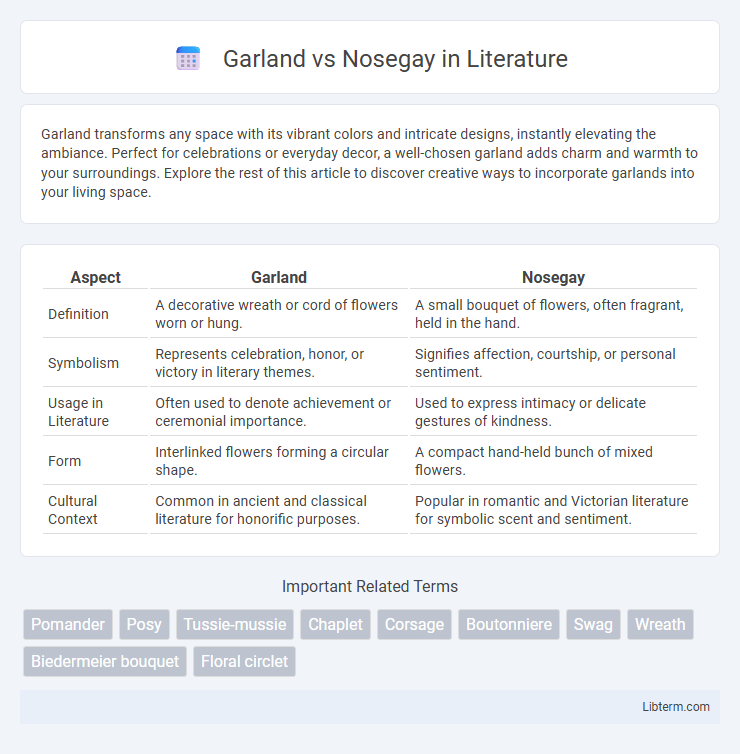Garland transforms any space with its vibrant colors and intricate designs, instantly elevating the ambiance. Perfect for celebrations or everyday decor, a well-chosen garland adds charm and warmth to your surroundings. Explore the rest of this article to discover creative ways to incorporate garlands into your living space.
Table of Comparison
| Aspect | Garland | Nosegay |
|---|---|---|
| Definition | A decorative wreath or cord of flowers worn or hung. | A small bouquet of flowers, often fragrant, held in the hand. |
| Symbolism | Represents celebration, honor, or victory in literary themes. | Signifies affection, courtship, or personal sentiment. |
| Usage in Literature | Often used to denote achievement or ceremonial importance. | Used to express intimacy or delicate gestures of kindness. |
| Form | Interlinked flowers forming a circular shape. | A compact hand-held bunch of mixed flowers. |
| Cultural Context | Common in ancient and classical literature for honorific purposes. | Popular in romantic and Victorian literature for symbolic scent and sentiment. |
Introduction to Garland and Nosegay
Garland refers to a decorative wreath or cord typically made of flowers, leaves, or other materials, often used to symbolize honor, celebration, or festivity. A Nosegay, historically, is a small bouquet of fragrant flowers carried or worn to provide a pleasant scent and ward off unpleasant odors. Both terms originate from floral arrangements but differ in size, purpose, and cultural significance.
Historical Origins of Garland and Nosegay
Garlands trace back to ancient civilizations such as Mesopotamia and Egypt, where they symbolized victory, honor, and celebration through woven flowers and leaves. Nosegays originated in medieval Europe as small bouquets carried to mask unpleasant odors, evolving into decorative gifts during the Renaissance. The historical use of garlands often emphasized public and ceremonial roles, while nosegays served more personal, fragrant purposes.
Key Differences in Design
Garland and Nosegay differ significantly in design, with Garland typically featuring a continuous, decorative arrangement of flowers woven or linked together, ideal for draping or hanging. Nosegay, by contrast, is a compact, hand-held bouquet designed for individual presentation, often rounded and tightly bound for ease of carrying. The structural distinction emphasizes Garland's ornamental use in large spaces, whereas Nosegay serves as a personal floral accessory.
Symbolic Meanings of Garland vs Nosegay
Garland symbolizes unity, celebration, and honor, often representing continuous life or victory through its circular form and use in rituals. Nosegay, a small bouquet of flowers, traditionally conveys personal affection, protection from illness, or discreet communication of emotions through the language of flowers. The garland emphasizes collective or ceremonial significance, while the nosegay highlights intimate, symbolic gestures in social and cultural contexts.
Common Materials Used in Both Styles
Garland and nosegay floral arrangements both commonly utilize greenery such as eucalyptus, ferns, and ivy to provide texture and volume. Popular flowers in both styles include roses, baby's breath, and carnations, which offer vibrant color and longevity. These materials create cohesive, elegant displays suited for weddings, events, and decorative purposes.
Popular Uses: Garland vs Nosegay
Garlands are widely used in weddings, festivals, and religious ceremonies as decorative strands of flowers symbolizing celebration and honor. Nosegays, smaller and more compact hand-tied bouquets, are popular as personal gifts, bridal bouquets, and in Victorian-era-inspired floral arrangements. Both serve aesthetic and symbolic roles but differ in form and typical usage contexts.
Cultural Significance Across Regions
The Garland and Nosegay represent distinct cultural expressions of floral symbolism, with the Garland deeply rooted in South Asian and Polynesian traditions as a symbol of honor and celebration, while the Nosegay carries European origins as a small bouquet intended for personal fragrance and social signaling in the Middle Ages. Regional variations highlight the Garland's use in religious ceremonies, weddings, and festivals, embodying spirituality and community bonds. In contrast, the Nosegay's significance evolved in Western societies as both a decorative accessory and a means to combat odors, reflecting historical shifts in hygiene and social customs.
Modern Trends in Decorative Arrangements
Garland vs. Nosegay exemplifies modern trends in decorative arrangements by highlighting the contrast between continuous floral designs and compact, hand-held bouquets. Garlands emphasize fluidity and natural flow, often used to accentuate architectural elements or create immersive environments. In contrast, nosegays focus on concentrated visual impact and portability, reflecting contemporary preferences for versatility and personal expression in floral decor.
Choosing Between Garland and Nosegay
Choosing between Garland and Nosegay requires evaluating their distinct aesthetic and symbolic qualities. Garland typically offers a larger, continuous arrangement ideal for decorating expansive spaces or ceremonies, while Nosegay provides a compact, hand-held design suited for personal gifts or intimate occasions. Consider the event's scale and purpose, as well as floral preferences, to select the arrangement that best conveys the intended sentiment.
Care Tips for Longevity and Freshness
Garland and Nosegay flowers require consistent hydration, ideally with water changed every two days to prevent bacterial growth and extend vase life. Keeping the stems trimmed at a 45-degree angle supports better water absorption, while placing the arrangements in a cool environment away from direct sunlight reduces wilting. Using floral preservatives can further nourish the blooms, ensuring prolonged freshness and vibrant appearance.
Garland Infographic

 libterm.com
libterm.com